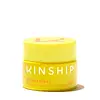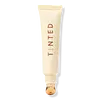What's inside
What's inside
 Key Ingredients
Key Ingredients

 Benefits
Benefits

 Concerns
Concerns

 Ingredients Side-by-side
Ingredients Side-by-side

Water
Skin ConditioningCetyl Alcohol
EmollientGlycerin
HumectantPotassium Cetyl Phosphate
EmulsifyingAvena Sativa Kernel Oil
Skin ConditioningSimmondsia Chinensis Seed Oil
EmollientAstrocaryum Tucuma Seed Butter
EmollientC12-15 Alkyl Benzoate
AntimicrobialCapryloyl Glycerin/Sebacic Acid Copolymer
Skin ConditioningDiheptyl Succinate
EmollientTetrahexyldecyl Ascorbate
AntioxidantSqualene
EmollientHippophae Rhamnoides Oil
EmollientJania Rubens Extract
Skin ConditioningLactobacillus Ferment
Skin ConditioningInonotus Obliquus Extract
Skin ConditioningMoringa Oleifera Seed Oil
EmollientArachidyl Alcohol
EmollientBehenyl Alcohol
EmollientArachidyl Glucoside
EmulsifyingJojoba Oil/Macadamia Seed Oil Esters
Skin ConditioningPhytosteryl Macadamiate
Skin ConditioningPhytosterols
Skin ConditioningTocopherol
AntioxidantBenzyl Alcohol
PerfumingSodium Carrageenan
Emulsion StabilisingBentonite
AbsorbentOlive Oil Decyl Esters
Hydrated Silica
AbrasiveCitric Acid
BufferingLactic Acid
BufferingChlorella Vulgaris Extract
Skin ConditioningSea Salt
AbrasiveEclipta Prostrata Extract
Skin ConditioningMelia Azadirachta Leaf Extract
Skin ConditioningSodium Phytate
Dehydroacetic Acid
PreservativePotassium Sorbate
PreservativePhenoxyethanol
PreservativeEthylhexylglycerin
Skin ConditioningWater, Cetyl Alcohol, Glycerin, Potassium Cetyl Phosphate, Avena Sativa Kernel Oil, Simmondsia Chinensis Seed Oil, Astrocaryum Tucuma Seed Butter, C12-15 Alkyl Benzoate, Capryloyl Glycerin/Sebacic Acid Copolymer, Diheptyl Succinate, Tetrahexyldecyl Ascorbate, Squalene, Hippophae Rhamnoides Oil, Jania Rubens Extract, Lactobacillus Ferment, Inonotus Obliquus Extract, Moringa Oleifera Seed Oil, Arachidyl Alcohol, Behenyl Alcohol, Arachidyl Glucoside, Jojoba Oil/Macadamia Seed Oil Esters, Phytosteryl Macadamiate, Phytosterols, Tocopherol, Benzyl Alcohol, Sodium Carrageenan, Bentonite, Olive Oil Decyl Esters, Hydrated Silica, Citric Acid, Lactic Acid, Chlorella Vulgaris Extract, Sea Salt, Eclipta Prostrata Extract, Melia Azadirachta Leaf Extract, Sodium Phytate, Dehydroacetic Acid, Potassium Sorbate, Phenoxyethanol, Ethylhexylglycerin
Water
Skin ConditioningGlycerin
HumectantDiisostearyl Malate
EmollientPolyglyceryl-2 Diisostearate
EmulsifyingTriethylhexanoin
MaskingCetearyl Olivate
Ammonium Acryloyldimethyltaurate/Vp Copolymer
Niacinamide
SmoothingCaffeine
Skin ConditioningTetrahexyldecyl Ascorbate
AntioxidantSodium Hyaluronate
HumectantChamomilla Recutita Flower Extract
MaskingCurcuma Longa Root Extract
MaskingButyrospermum Parkii Butter
Skin ConditioningMica
Cosmetic ColorantSorbitan Olivate
EmulsifyingIsostearyl Alcohol
EmollientTocopherol
AntioxidantXanthan Gum
EmulsifyingEthylhexylglycerin
Skin ConditioningButylene Glycol
HumectantTrisodium Ethylenediamine Disuccinate
Malic Acid
BufferingCitric Acid
BufferingSodium Hydroxide
BufferingCaprylyl Glycol
EmollientSorbic Acid
PreservativePhenoxyethanol
PreservativeCI 77891
Cosmetic ColorantIron Oxides
Water, Glycerin, Diisostearyl Malate, Polyglyceryl-2 Diisostearate, Triethylhexanoin, Cetearyl Olivate, Ammonium Acryloyldimethyltaurate/Vp Copolymer, Niacinamide, Caffeine, Tetrahexyldecyl Ascorbate, Sodium Hyaluronate, Chamomilla Recutita Flower Extract, Curcuma Longa Root Extract, Butyrospermum Parkii Butter, Mica, Sorbitan Olivate, Isostearyl Alcohol, Tocopherol, Xanthan Gum, Ethylhexylglycerin, Butylene Glycol, Trisodium Ethylenediamine Disuccinate, Malic Acid, Citric Acid, Sodium Hydroxide, Caprylyl Glycol, Sorbic Acid, Phenoxyethanol, CI 77891, Iron Oxides
Alternatives
Ingredients Explained
These ingredients are found in both products.
Ingredients higher up in an ingredient list are typically present in a larger amount.
Citric Acid is an alpha hydroxy acid (AHA) naturally found in citrus fruits like oranges, lemons, and limes.
Like other AHAs, citric acid can exfoliate skin by breaking down the bonds that hold dead skin cells together. This helps reveal smoother and brighter skin underneath.
However, this exfoliating effect only happens at high concentrations (20%) which can be hard to find in cosmetic products.
Due to this, citric acid is usually included in small amounts as a pH adjuster. This helps keep products slightly more acidic and compatible with skin's natural pH.
In skincare formulas, citric acid can:
While it can provide some skin benefits, research shows lactic acid and glycolic acid are generally more effective and less irritating exfoliants.
Most citric acid used in skincare today is made by fermenting sugars (usually from molasses). This synthetic version is identical to the natural citrus form but easier to stabilize and use in formulations.
Read more about some other popular AHA's here:
Learn more about Citric AcidEthylhexylglycerin (we can't pronounce this either) is commonly used as a preservative and skin softener. It is derived from glyceryl.
You might see Ethylhexylglycerin often paired with other preservatives such as phenoxyethanol. Ethylhexylglycerin has been found to increase the effectiveness of these other preservatives.
Glycerin is already naturally found in your skin. It helps moisturize and protect your skin.
A study from 2016 found glycerin to be more effective as a humectant than AHAs and hyaluronic acid.
As a humectant, it helps the skin stay hydrated by pulling moisture to your skin. The low molecular weight of glycerin allows it to pull moisture into the deeper layers of your skin.
Hydrated skin improves your skin barrier; Your skin barrier helps protect against irritants and bacteria.
Glycerin has also been found to have antimicrobial and antiviral properties. Due to these properties, glycerin is often used in wound and burn treatments.
In cosmetics, glycerin is usually derived from plants such as soybean or palm. However, it can also be sourced from animals, such as tallow or animal fat.
This ingredient is organic, colorless, odorless, and non-toxic.
Glycerin is the name for this ingredient in American English. British English uses Glycerol/Glycerine.
Learn more about GlycerinPhenoxyethanol is a preservative that has germicide, antimicrobial, and aromatic properties. Studies show that phenoxyethanol can prevent microbial growth. By itself, it has a scent that is similar to that of a rose.
It's often used in formulations along with Caprylyl Glycol to preserve the shelf life of products.
Tetrahexyldecyl Ascorbate (THD) is a stable and oil-soluble form of Vitamin C.
THD is special in that it has the ability to travel deeper into skin than traditional ascorbic acid while maintaining the same skin benefits (double win!).
Because it’s oil-soluble, THD dives deep into your skin’s fatty layers (think ceramides and cholesterol) to fight off the kind of free radicals that mess with your skin barrier. This makes it a great pair with water-based vitamin C (ascorbic acid) that mainly works on the surface.
Even at just 0.1%, THD is already showing great antioxidant activity. When used up to 2%, it helps keep your skin happy and calm, especially when it’s stressed from pollution or sun.
Want to fade dark spots or tackle hyperpigmentation? You’ll want 5% or more. Pairing it with brightening buddies like niacinamide or licorice root gives even better results. One study even used 30% THD with other brighteners and saw real results on stubborn discoloration, even in melasma-prone skin.
A note on THD: It’s has a slightly silky, oily texture and usually shows up colorless or pale yellow (though the exact shade can vary by supplier).
While you can sneak it into water-based formulas, it really shines when paired with silicones or oils, which help your skin soak it up better.
THD is pretty stable, but it’s still vulnerable to degradation like ascorbic acid. Too much light or heat (above 113°F / 45°C) can break it down over time. Go for dark and opaque packaging that keeps it safe and shady!
Read more about other types of Vitamin C:
Learn more about Tetrahexyldecyl AscorbateTocopherol (also known as Vitamin E) is a common antioxidant used to help protect the skin from free-radicals and strengthen the skin barrier. It's also fat soluble - this means our skin is great at absorbing it.
Vitamin E also helps keep your natural skin lipids healthy. Your lipid skin barrier naturally consists of lipids, ceramides, and fatty acids. Vitamin E offers extra protection for your skin’s lipid barrier, keeping your skin healthy and nourished.
Another benefit is a bit of UV protection. Vitamin E helps reduce the damage caused by UVB rays. (It should not replace your sunscreen). Combining it with Vitamin C can decrease sunburned cells and hyperpigmentation after UV exposure.
You might have noticed Vitamin E + C often paired together. This is because it is great at stabilizing Vitamin C. Using the two together helps increase the effectiveness of both ingredients.
There are often claims that Vitamin E can reduce/prevent scarring, but these claims haven't been confirmed by scientific research.
Learn more about TocopherolWater. It's the most common cosmetic ingredient of all. You'll usually see it at the top of ingredient lists, meaning that it makes up the largest part of the product.
So why is it so popular? Water most often acts as a solvent - this means that it helps dissolve other ingredients into the formulation.
You'll also recognize water as that liquid we all need to stay alive. If you see this, drink a glass of water. Stay hydrated!
Learn more about Water